
April 12 2024 Prelims Practice Questions (PPQs)
Subscribe to Never Miss an Important Update! Assured Discounts on New Products!
Must Join PMF IAS Telegram Channel & PMF IAS History Telegram Channel
- These Prelims Practice Questions (PPQs) are based on PMF IAS Daily Current Affairs.
- The daily current affairs are uploaded every day by 8 PM. You can read the Daily Current Affairs from here.
- Subscribers of the “Current Affairs” course can Download Daily Current Affairs in PDF/DOC from here.
[Quiz] Daily Prelims Practice Questions (PPQs) – April 12 2024
0 of 9 questions completed
Questions:
- 1
- 2
- 3
- 4
- 5
- 6
- 7
- 8
- 9
Information
These MCQs are based on PMF IAS Daily Current Affairs. The daily current affairs are uploaded every day by 8 PM. You can read the Daily Current Affairs from here. Subscribers of the “Current Affairs” course can Download Daily Current Affairs in PDF/DOC from here.
You have already completed the Test before. Hence you can not start it again.
Test is loading...
You must sign in or sign up to start the Test.
You have to finish following quiz, to start this Test:
Your results are here!! for" [Quiz] Daily Prelims Practice Questions (PPQs) – April 12 2024 "
0 of 9 questions answered correctly
Your time:
Time has elapsed
Your Final Score is : 0
You have attempted : 0
Number of Correct Questions : 0 and scored 0
Number of Incorrect Questions : 0 and Negative marks 0
| Average score |
|
| Your score |
|
-
Not categorized
You have attempted: 0
Number of Correct Questions: 0 and scored 0
Number of Incorrect Questions: 0 and Negative marks 0
| Pos. | Name | Entered on | Points | Result |
|---|---|---|---|---|
| Table is loading | ||||
| No data available | ||||
- 1
- 2
- 3
- 4
- 5
- 6
- 7
- 8
- 9
- Answered
- Review
-
Question 1 of 9
1. Question
Q1. {Envi – Species} Consider the following statements about Baobab Tree:
- It is a long-lived deciduous tree with broad trunks and compact tops.
- Of the 9 species of baobab tree two are native to Portugal.
- In India, the baobab tree were first brought by the Portuguese for it’s medicinal properties.
How many of the above statement(s) is/are correct?
Correct
Explanation
Statement 1 is correct
- Baobab is a long-lived deciduous, small to large tree with broad trunks and compact tops which is also known as the upside-down tree.
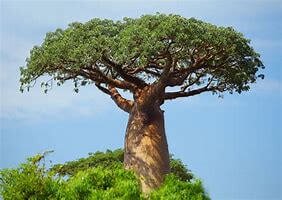
- It can live to become thousands of years old.
- They only have very faint growth rings. Mature trees have massive trunks that are bottle-shaped or cylindrical and tapered from bottom to top.
- The fruit of the tree is round or oval-shaped and is highly nutritious.
- It is also known as ‘Tree of Life’.
Statement 2 is incorrect
- There are 9 species of baobab tree. Two are native to mainland Africa, six to Madagascar, and one to Australia.
- Baobabs are keystone species in Madagascar’s unique landscapes.
- Their massive trunks and extensive root systems are vital for storing water in arid environments, providing a critical resource for both the trees and the surrounding ecosystem during drought periods.
Statement 3 is incorrect
- Mandu, in the Dhar district of Madhya Pradesh, is perhaps the only place in India where baobab trees are found in abundance.
- Baobabs provide livelihoods to the people of Mandu. Shopkeepers sell fruit pods as a souvenir to tourists.
- The shopkeepers, largely members of the Bhil tribe, either collect them from the nearby jungle or buy them from people who grow baobabs. Tribal people have been instrumental in saving these trees till now.
- Baobab tree seeds were brought to Mandu by the Afghan rulers or Arab traders who came to Mandu around 1400 AD. It quenches thirst besides having other medicinal qualities.
Answer: (a) Only one; Difficulty Level: Medium
Incorrect
Explanation
Statement 1 is correct
- Baobab is a long-lived deciduous, small to large tree with broad trunks and compact tops which is also known as the upside-down tree.

- It can live to become thousands of years old.
- They only have very faint growth rings. Mature trees have massive trunks that are bottle-shaped or cylindrical and tapered from bottom to top.
- The fruit of the tree is round or oval-shaped and is highly nutritious.
- It is also known as ‘Tree of Life’.
Statement 2 is incorrect
- There are 9 species of baobab tree. Two are native to mainland Africa, six to Madagascar, and one to Australia.
- Baobabs are keystone species in Madagascar’s unique landscapes.
- Their massive trunks and extensive root systems are vital for storing water in arid environments, providing a critical resource for both the trees and the surrounding ecosystem during drought periods.
Statement 3 is incorrect
- Mandu, in the Dhar district of Madhya Pradesh, is perhaps the only place in India where baobab trees are found in abundance.
- Baobabs provide livelihoods to the people of Mandu. Shopkeepers sell fruit pods as a souvenir to tourists.
- The shopkeepers, largely members of the Bhil tribe, either collect them from the nearby jungle or buy them from people who grow baobabs. Tribal people have been instrumental in saving these trees till now.
- Baobab tree seeds were brought to Mandu by the Afghan rulers or Arab traders who came to Mandu around 1400 AD. It quenches thirst besides having other medicinal qualities.
Answer: (a) Only one; Difficulty Level: Medium
Unattempted
Explanation
Statement 1 is correct
- Baobab is a long-lived deciduous, small to large tree with broad trunks and compact tops which is also known as the upside-down tree.

- It can live to become thousands of years old.
- They only have very faint growth rings. Mature trees have massive trunks that are bottle-shaped or cylindrical and tapered from bottom to top.
- The fruit of the tree is round or oval-shaped and is highly nutritious.
- It is also known as ‘Tree of Life’.
Statement 2 is incorrect
- There are 9 species of baobab tree. Two are native to mainland Africa, six to Madagascar, and one to Australia.
- Baobabs are keystone species in Madagascar’s unique landscapes.
- Their massive trunks and extensive root systems are vital for storing water in arid environments, providing a critical resource for both the trees and the surrounding ecosystem during drought periods.
Statement 3 is incorrect
- Mandu, in the Dhar district of Madhya Pradesh, is perhaps the only place in India where baobab trees are found in abundance.
- Baobabs provide livelihoods to the people of Mandu. Shopkeepers sell fruit pods as a souvenir to tourists.
- The shopkeepers, largely members of the Bhil tribe, either collect them from the nearby jungle or buy them from people who grow baobabs. Tribal people have been instrumental in saving these trees till now.
- Baobab tree seeds were brought to Mandu by the Afghan rulers or Arab traders who came to Mandu around 1400 AD. It quenches thirst besides having other medicinal qualities.
Answer: (a) Only one; Difficulty Level: Medium
-
Question 2 of 9
2. Question
Q2. {IE – Infrastructure} Consider the following statements about National Investment and Infrastructure Fund (NIIF):
- It is India’s first-ever sovereign wealth fund (SWF) set up in 2015, which invests only in Green Field Projects.
- Being 49% owned by the Indian government, the NIIF is dependent on GoI for its investment decisions.
Which of the above statement(s) is/are correct?
Correct
Explanation
Statement 1 is incorrect
- NIIF is a fund manager that invests in infrastructure and related sectors in India.
- It is India’s first-ever sovereign wealth fund (SWF), which was set up in 2015.
- An institution anchored by the Government of India, NIIF is a collaborative investment platform for international and Indian investors with a mandate to invest equity capital in domestic infrastructure.
- NIIF invests across asset classes such as infrastructure, private equity, and other diversified sectors in India, with the objective of generating attractive risk-adjusted returns for its investors.
- It invests in greenfield (new), brownfield (existing), and stalled projects.
Statement 2 is incorrect
- NIIF is 49% owned by the Indian government and has more than $4.9 billion in assets under management, making it the country’s biggest infrastructure fund.
- NIIF benefits from its association with the Government yet is independent in its investment decisions.
- It is majority-owned by institutional investors and managed professionally by a team with experience in investments and infrastructure.
- The funds are registered as Alternative Investment Fund (AIF) with the Securities Exchange Board of India (SEBI) and are currently raising capital from domestic and international institutional investors.
Answer: (d) Neither 1 nor 2; Difficulty Level: Medium
Incorrect
Explanation
Statement 1 is incorrect
- NIIF is a fund manager that invests in infrastructure and related sectors in India.
- It is India’s first-ever sovereign wealth fund (SWF), which was set up in 2015.
- An institution anchored by the Government of India, NIIF is a collaborative investment platform for international and Indian investors with a mandate to invest equity capital in domestic infrastructure.
- NIIF invests across asset classes such as infrastructure, private equity, and other diversified sectors in India, with the objective of generating attractive risk-adjusted returns for its investors.
- It invests in greenfield (new), brownfield (existing), and stalled projects.
Statement 2 is incorrect
- NIIF is 49% owned by the Indian government and has more than $4.9 billion in assets under management, making it the country’s biggest infrastructure fund.
- NIIF benefits from its association with the Government yet is independent in its investment decisions.
- It is majority-owned by institutional investors and managed professionally by a team with experience in investments and infrastructure.
- The funds are registered as Alternative Investment Fund (AIF) with the Securities Exchange Board of India (SEBI) and are currently raising capital from domestic and international institutional investors.
Answer: (d) Neither 1 nor 2; Difficulty Level: Medium
Unattempted
Explanation
Statement 1 is incorrect
- NIIF is a fund manager that invests in infrastructure and related sectors in India.
- It is India’s first-ever sovereign wealth fund (SWF), which was set up in 2015.
- An institution anchored by the Government of India, NIIF is a collaborative investment platform for international and Indian investors with a mandate to invest equity capital in domestic infrastructure.
- NIIF invests across asset classes such as infrastructure, private equity, and other diversified sectors in India, with the objective of generating attractive risk-adjusted returns for its investors.
- It invests in greenfield (new), brownfield (existing), and stalled projects.
Statement 2 is incorrect
- NIIF is 49% owned by the Indian government and has more than $4.9 billion in assets under management, making it the country’s biggest infrastructure fund.
- NIIF benefits from its association with the Government yet is independent in its investment decisions.
- It is majority-owned by institutional investors and managed professionally by a team with experience in investments and infrastructure.
- The funds are registered as Alternative Investment Fund (AIF) with the Securities Exchange Board of India (SEBI) and are currently raising capital from domestic and international institutional investors.
Answer: (d) Neither 1 nor 2; Difficulty Level: Medium
-
Question 3 of 9
3. Question
Q3. {Prelims – S&T – Space} In which one of the following ways does PSLV Orbital Experimental Module-3 (POEM-3) contribute to reducing space debris?
Correct
Explanation
- PSLV Orbital Experimental Module-3 (POEM-3) was the fourth stage of a PSLV rocket that was converted into a functional platform after deploying its satellites.
- Traditionally, these rocket stages end up as space debris after they complete their primary function.
- POEM-3, however, was designed to re-enter Earth’s atmosphere at the end of its mission.
- This controlled re-entry resulted in the module burning up completely, eliminating the possibility of it adding to the growing problem of space debris.
Answer: (b) By de-orbiting and burning up in the earth atmosphere after its mission; Difficulty Level: Medium
Incorrect
Explanation
- PSLV Orbital Experimental Module-3 (POEM-3) was the fourth stage of a PSLV rocket that was converted into a functional platform after deploying its satellites.
- Traditionally, these rocket stages end up as space debris after they complete their primary function.
- POEM-3, however, was designed to re-enter Earth’s atmosphere at the end of its mission.
- This controlled re-entry resulted in the module burning up completely, eliminating the possibility of it adding to the growing problem of space debris.
Answer: (b) By de-orbiting and burning up in the earth atmosphere after its mission; Difficulty Level: Medium
Unattempted
Explanation
- PSLV Orbital Experimental Module-3 (POEM-3) was the fourth stage of a PSLV rocket that was converted into a functional platform after deploying its satellites.
- Traditionally, these rocket stages end up as space debris after they complete their primary function.
- POEM-3, however, was designed to re-enter Earth’s atmosphere at the end of its mission.
- This controlled re-entry resulted in the module burning up completely, eliminating the possibility of it adding to the growing problem of space debris.
Answer: (b) By de-orbiting and burning up in the earth atmosphere after its mission; Difficulty Level: Medium
-
Question 4 of 9
4. Question
Q4. {Prelims – IR – Organisations} Which one of the following is not a primary function of the International Narcotics Control Board (INCB)?
Correct
Explanation
- Investigating and prosecuting international drug trafficking organizations is not a primary function of the INCB.
- This responsibility typically falls under the purview of national law enforcement agencies and international organizations such as the International Criminal Police Organization (INTERPOL) and the United Nations Office on Drugs and Crime (UNODC).
- INCB was established in 1968.
- This board is the independent and quasi-judicial monitoring body for the implementation of the United Nations international drug control conventions.
- According to information about its mandate on its website, INCB endeavours, in cooperation with Governments, to ensure that adequate supplies of drugs are available for medical and scientific uses and that the diversion of drugs from licit sources to illicit channels does not occur.
- It consists of 13 members who are elected by the Economic and Social Council.
- The members serve in their personal capacity and are not government representatives.
Answer: (b) Investigating and prosecuting international drug trafficking organizations; Difficulty Level: Medium
Incorrect
Explanation
- Investigating and prosecuting international drug trafficking organizations is not a primary function of the INCB.
- This responsibility typically falls under the purview of national law enforcement agencies and international organizations such as the International Criminal Police Organization (INTERPOL) and the United Nations Office on Drugs and Crime (UNODC).
- INCB was established in 1968.
- This board is the independent and quasi-judicial monitoring body for the implementation of the United Nations international drug control conventions.
- According to information about its mandate on its website, INCB endeavours, in cooperation with Governments, to ensure that adequate supplies of drugs are available for medical and scientific uses and that the diversion of drugs from licit sources to illicit channels does not occur.
- It consists of 13 members who are elected by the Economic and Social Council.
- The members serve in their personal capacity and are not government representatives.
Answer: (b) Investigating and prosecuting international drug trafficking organizations; Difficulty Level: Medium
Unattempted
Explanation
- Investigating and prosecuting international drug trafficking organizations is not a primary function of the INCB.
- This responsibility typically falls under the purview of national law enforcement agencies and international organizations such as the International Criminal Police Organization (INTERPOL) and the United Nations Office on Drugs and Crime (UNODC).
- INCB was established in 1968.
- This board is the independent and quasi-judicial monitoring body for the implementation of the United Nations international drug control conventions.
- According to information about its mandate on its website, INCB endeavours, in cooperation with Governments, to ensure that adequate supplies of drugs are available for medical and scientific uses and that the diversion of drugs from licit sources to illicit channels does not occur.
- It consists of 13 members who are elected by the Economic and Social Council.
- The members serve in their personal capacity and are not government representatives.
Answer: (b) Investigating and prosecuting international drug trafficking organizations; Difficulty Level: Medium
-
Question 5 of 9
5. Question
Q5. {Internal Security – Money Laundering} Consider the following statements with respect to the Prevention of Money Laundering Act (PMLA):
- The PMLA was enacted in response to the political declaration adopted by the special session of the United Nations.
- The Enforcement Directorate (ED) is the main agency probing allegations under PMLA.
- There is no legal provision under the PMLA that provides for bail on money laundering charges.
How many of the above statement(s) is/are correct?
Correct
Explanation
Statement 1 is correct
- The PMLA was enacted in response to the political declaration adopted by the special session of the United Nations General Assembly held on June 8 and 10, 1998.
- The special session called on member states to put in place national anti-money laundering legislation.
- The main focus of the PMLA is:
- To prevent money-laundering
- To provide for confiscation of property derived from or involved in money-laundering.
Statement 2 is correct
- The Enforcement Directorate (ED) is the main agency probing allegations under PMLA.
Statement 3 is incorrect
- Section 45 of the PMLA provides for bail on money laundering charges.
- Section 45(1) – No person accused of an offence under this Act shall be released on bail or on his own bond unless:
- The Public Prosecutor has been given an opportunity to oppose the application for such release.
- Where the Public Prosecutor opposes the application, the Court is satisfied that there are reasonable grounds for believing that he is not guilty of such offence and that he is not likely to commit any offence while on bail.
- However, there is a crucial exception to the bail standard.
- Provided that a person, who is under the age of sixteen years or is a woman or is sick or infirm (not physically or mentally strong), may be released on bail, if the Special Court so directs.
- This exception is similar to exemptions under the Indian Penal Code for women and minors.
Answer: (b) Only two; Difficulty Level: Medium
Incorrect
Explanation
Statement 1 is correct
- The PMLA was enacted in response to the political declaration adopted by the special session of the United Nations General Assembly held on June 8 and 10, 1998.
- The special session called on member states to put in place national anti-money laundering legislation.
- The main focus of the PMLA is:
- To prevent money-laundering
- To provide for confiscation of property derived from or involved in money-laundering.
Statement 2 is correct
- The Enforcement Directorate (ED) is the main agency probing allegations under PMLA.
Statement 3 is incorrect
- Section 45 of the PMLA provides for bail on money laundering charges.
- Section 45(1) – No person accused of an offence under this Act shall be released on bail or on his own bond unless:
- The Public Prosecutor has been given an opportunity to oppose the application for such release.
- Where the Public Prosecutor opposes the application, the Court is satisfied that there are reasonable grounds for believing that he is not guilty of such offence and that he is not likely to commit any offence while on bail.
- However, there is a crucial exception to the bail standard.
- Provided that a person, who is under the age of sixteen years or is a woman or is sick or infirm (not physically or mentally strong), may be released on bail, if the Special Court so directs.
- This exception is similar to exemptions under the Indian Penal Code for women and minors.
Answer: (b) Only two; Difficulty Level: Medium
Unattempted
Explanation
Statement 1 is correct
- The PMLA was enacted in response to the political declaration adopted by the special session of the United Nations General Assembly held on June 8 and 10, 1998.
- The special session called on member states to put in place national anti-money laundering legislation.
- The main focus of the PMLA is:
- To prevent money-laundering
- To provide for confiscation of property derived from or involved in money-laundering.
Statement 2 is correct
- The Enforcement Directorate (ED) is the main agency probing allegations under PMLA.
Statement 3 is incorrect
- Section 45 of the PMLA provides for bail on money laundering charges.
- Section 45(1) – No person accused of an offence under this Act shall be released on bail or on his own bond unless:
- The Public Prosecutor has been given an opportunity to oppose the application for such release.
- Where the Public Prosecutor opposes the application, the Court is satisfied that there are reasonable grounds for believing that he is not guilty of such offence and that he is not likely to commit any offence while on bail.
- However, there is a crucial exception to the bail standard.
- Provided that a person, who is under the age of sixteen years or is a woman or is sick or infirm (not physically or mentally strong), may be released on bail, if the Special Court so directs.
- This exception is similar to exemptions under the Indian Penal Code for women and minors.
Answer: (b) Only two; Difficulty Level: Medium
-
Question 6 of 9
6. Question
Q6. {Geo – PG – Climatology} Consider the following statements with respect to Volcanic Vortex Rings:
- Vortex rings are generated when gas, predominantly water vapour, is released rapidly through a vent in the crater.
- Volcanic Vortex Rings are only observed at volcanoes in European region.
Which of the above statement(s) is/are correct?
Correct
Explanation
Statement 1 is correct
- Vortex rings are generated when gas, predominantly water vapour, is released rapidly through a vent in the crater.
- The vent that has opened up in Etna’s crater is almost perfectly circular, so the rings that have been seen above the mountain since April 2 are also circular.
- Volcanic smoke rings were produced in the same way as dolphins blow bubble rings.
- Dolphins compress the water in their mouths, and using their tongue they push it out of their mouths and create such a pressure that it forms a ring.
- The rings can remain in the air for up to 10 minutes, but tend to disintegrate quickly if conditions are windy and turbulent.

Statement 2 is incorrect
- The phenomenon was first observed at Etna and Vesuvius in Italy in 1724, and has been documented in an engraved plate from 1755.
- In more recent times, volcanic vortex rings have been observed at volcanoes such as Redoubt in Alaska, Tungurahua in Ecuador, Pacaya in Guatemala, Eyjafjallajökull and Hekla in Iceland, Stromboli in Italy, Aso and Sakurajima in Japan, Yasur in Vanuatu, Whakaari in New Zealand, and Momotombo in Nicaragua.
Answer: (a) 1 only; Difficulty Level: Medium
Incorrect
Explanation
Statement 1 is correct
- Vortex rings are generated when gas, predominantly water vapour, is released rapidly through a vent in the crater.
- The vent that has opened up in Etna’s crater is almost perfectly circular, so the rings that have been seen above the mountain since April 2 are also circular.
- Volcanic smoke rings were produced in the same way as dolphins blow bubble rings.
- Dolphins compress the water in their mouths, and using their tongue they push it out of their mouths and create such a pressure that it forms a ring.
- The rings can remain in the air for up to 10 minutes, but tend to disintegrate quickly if conditions are windy and turbulent.

Statement 2 is incorrect
- The phenomenon was first observed at Etna and Vesuvius in Italy in 1724, and has been documented in an engraved plate from 1755.
- In more recent times, volcanic vortex rings have been observed at volcanoes such as Redoubt in Alaska, Tungurahua in Ecuador, Pacaya in Guatemala, Eyjafjallajökull and Hekla in Iceland, Stromboli in Italy, Aso and Sakurajima in Japan, Yasur in Vanuatu, Whakaari in New Zealand, and Momotombo in Nicaragua.
Answer: (a) 1 only; Difficulty Level: Medium
Unattempted
Explanation
Statement 1 is correct
- Vortex rings are generated when gas, predominantly water vapour, is released rapidly through a vent in the crater.
- The vent that has opened up in Etna’s crater is almost perfectly circular, so the rings that have been seen above the mountain since April 2 are also circular.
- Volcanic smoke rings were produced in the same way as dolphins blow bubble rings.
- Dolphins compress the water in their mouths, and using their tongue they push it out of their mouths and create such a pressure that it forms a ring.
- The rings can remain in the air for up to 10 minutes, but tend to disintegrate quickly if conditions are windy and turbulent.

Statement 2 is incorrect
- The phenomenon was first observed at Etna and Vesuvius in Italy in 1724, and has been documented in an engraved plate from 1755.
- In more recent times, volcanic vortex rings have been observed at volcanoes such as Redoubt in Alaska, Tungurahua in Ecuador, Pacaya in Guatemala, Eyjafjallajökull and Hekla in Iceland, Stromboli in Italy, Aso and Sakurajima in Japan, Yasur in Vanuatu, Whakaari in New Zealand, and Momotombo in Nicaragua.
Answer: (a) 1 only; Difficulty Level: Medium
-
Question 7 of 9
7. Question
Q7. {Prelims – Tribes} Which one of the following statement is not correct with respect to the Muria Tribes?
Correct
Explanation
- They are concentrated in the states of Telangana, Andhra Pradesh, Chhattisgarh, and Odisha.
- The Muria settlements are known as habitations of Internally Displaced People (IDPs).
- Their population is around 6,600 in Andhra Pradesh.
- The Murias are referred to as ‘Gutti Koyas’ by the native tribes.
- They speak Koya, which is Dravidian language.
- The most important fair celebrated by Koyas is the Sammakka Saralamma Jatra.
- It is celebrated once in two years on full moon day of the Magha Masam (January or February).
- They practice Podu form of shifting cultivation.
- They held ST status in Chattisgarh but they were not granted ST status in their migrated states such as Telangana and Andhra Pradesh.
- The absence of the caste certificate also makes the Murias ineligible to claim any social welfare pension, including old-age, widow and differently-abled pensions in these states.
Answer: (a) They have been awarded the Scheduled Tribe status in Andhra Pradesh; Difficulty Level: Medium
Incorrect
Explanation
- They are concentrated in the states of Telangana, Andhra Pradesh, Chhattisgarh, and Odisha.
- The Muria settlements are known as habitations of Internally Displaced People (IDPs).
- Their population is around 6,600 in Andhra Pradesh.
- The Murias are referred to as ‘Gutti Koyas’ by the native tribes.
- They speak Koya, which is Dravidian language.
- The most important fair celebrated by Koyas is the Sammakka Saralamma Jatra.
- It is celebrated once in two years on full moon day of the Magha Masam (January or February).
- They practice Podu form of shifting cultivation.
- They held ST status in Chattisgarh but they were not granted ST status in their migrated states such as Telangana and Andhra Pradesh.
- The absence of the caste certificate also makes the Murias ineligible to claim any social welfare pension, including old-age, widow and differently-abled pensions in these states.
Answer: (a) They have been awarded the Scheduled Tribe status in Andhra Pradesh; Difficulty Level: Medium
Unattempted
Explanation
- They are concentrated in the states of Telangana, Andhra Pradesh, Chhattisgarh, and Odisha.
- The Muria settlements are known as habitations of Internally Displaced People (IDPs).
- Their population is around 6,600 in Andhra Pradesh.
- The Murias are referred to as ‘Gutti Koyas’ by the native tribes.
- They speak Koya, which is Dravidian language.
- The most important fair celebrated by Koyas is the Sammakka Saralamma Jatra.
- It is celebrated once in two years on full moon day of the Magha Masam (January or February).
- They practice Podu form of shifting cultivation.
- They held ST status in Chattisgarh but they were not granted ST status in their migrated states such as Telangana and Andhra Pradesh.
- The absence of the caste certificate also makes the Murias ineligible to claim any social welfare pension, including old-age, widow and differently-abled pensions in these states.
Answer: (a) They have been awarded the Scheduled Tribe status in Andhra Pradesh; Difficulty Level: Medium
-
Question 8 of 9
8. Question
Q8. {Prelims – S&T – AI} Consider the following statements about GPT-4 Vision:
- It allows users to upload an image as input and ask a question about it, which makes it suitable for interpreting specialized medical images like CT scans.
- It works on the principle of Large Multimodal Model (LMM) and can interpret images with text of non-Latin alphabets, such as Japanese or Korean.
Which of the above statement(s) is/are correct?
Correct
Explanation
Statement 1 is incorrect
- GPT-4 with Vision, also referred to as GPT-4V, allows users to instruct GPT-4 to analyse image inputs.
- GPT-4 Vision has been considered OpenAI’s step forward towards making its chatbot multimodal, an AI model with a combination of image, text, and audio as inputs.
- It allows users to upload an image as input and ask a question about it.
- This task is known as visual question answering (VQA).
- GPT-4 Vision has some groundbreaking capabilities such as processing visual content including photographs, screenshots, and documents.
- The latest iteration allows it to perform a slew of tasks such as identifying objects within images, and interpreting and analysing data displayed in graphs, charts, and other visualisations.
- The model is not suitable for interpreting specialized medical images like CT scans and shouldn’t be used for medical advice.
- GPT-4 Vision can also interpret handwritten and printed text contained within images.
- This is a significant leap in AI as it, in a way, bridges the gap between visual understanding and textual analysis.
Statement 2 is incorrect
- GPT-4 Vision is a Large Multimodal Model (LMM).
- LLM is essentially a model that is capable of taking information in multiple modalities like text and images or text and audio and generating responses based on it.
- It is not the first and only LMM, there are many others such as CogVLM, LLaVA, Kosmos-2, etc.
- The model may not perform optimally when handling images with text of non-Latin alphabets, such as Japanese or Korean.
- Enlarge text within the image to improve readability, but avoid cropping important details.
- The model struggles with tasks requiring precise spatial localization, such as identifying chess positions.
Answer: (d) Neither 1 nor 2; Difficulty Level: Medium
Incorrect
Explanation
Statement 1 is incorrect
- GPT-4 with Vision, also referred to as GPT-4V, allows users to instruct GPT-4 to analyse image inputs.
- GPT-4 Vision has been considered OpenAI’s step forward towards making its chatbot multimodal, an AI model with a combination of image, text, and audio as inputs.
- It allows users to upload an image as input and ask a question about it.
- This task is known as visual question answering (VQA).
- GPT-4 Vision has some groundbreaking capabilities such as processing visual content including photographs, screenshots, and documents.
- The latest iteration allows it to perform a slew of tasks such as identifying objects within images, and interpreting and analysing data displayed in graphs, charts, and other visualisations.
- The model is not suitable for interpreting specialized medical images like CT scans and shouldn’t be used for medical advice.
- GPT-4 Vision can also interpret handwritten and printed text contained within images.
- This is a significant leap in AI as it, in a way, bridges the gap between visual understanding and textual analysis.
Statement 2 is incorrect
- GPT-4 Vision is a Large Multimodal Model (LMM).
- LLM is essentially a model that is capable of taking information in multiple modalities like text and images or text and audio and generating responses based on it.
- It is not the first and only LMM, there are many others such as CogVLM, LLaVA, Kosmos-2, etc.
- The model may not perform optimally when handling images with text of non-Latin alphabets, such as Japanese or Korean.
- Enlarge text within the image to improve readability, but avoid cropping important details.
- The model struggles with tasks requiring precise spatial localization, such as identifying chess positions.
Answer: (d) Neither 1 nor 2; Difficulty Level: Medium
Unattempted
Explanation
Statement 1 is incorrect
- GPT-4 with Vision, also referred to as GPT-4V, allows users to instruct GPT-4 to analyse image inputs.
- GPT-4 Vision has been considered OpenAI’s step forward towards making its chatbot multimodal, an AI model with a combination of image, text, and audio as inputs.
- It allows users to upload an image as input and ask a question about it.
- This task is known as visual question answering (VQA).
- GPT-4 Vision has some groundbreaking capabilities such as processing visual content including photographs, screenshots, and documents.
- The latest iteration allows it to perform a slew of tasks such as identifying objects within images, and interpreting and analysing data displayed in graphs, charts, and other visualisations.
- The model is not suitable for interpreting specialized medical images like CT scans and shouldn’t be used for medical advice.
- GPT-4 Vision can also interpret handwritten and printed text contained within images.
- This is a significant leap in AI as it, in a way, bridges the gap between visual understanding and textual analysis.
Statement 2 is incorrect
- GPT-4 Vision is a Large Multimodal Model (LMM).
- LLM is essentially a model that is capable of taking information in multiple modalities like text and images or text and audio and generating responses based on it.
- It is not the first and only LMM, there are many others such as CogVLM, LLaVA, Kosmos-2, etc.
- The model may not perform optimally when handling images with text of non-Latin alphabets, such as Japanese or Korean.
- Enlarge text within the image to improve readability, but avoid cropping important details.
- The model struggles with tasks requiring precise spatial localization, such as identifying chess positions.
Answer: (d) Neither 1 nor 2; Difficulty Level: Medium
-
Question 9 of 9
9. Question
Q9. {Prelims – Reports & Indices} Which of the following organisation released the Global Trade Outlook and Statistics report?
Correct
Explanation
- Global Trade Outlook and Statistics report is released by the World Trade Organisation (WTO).
- The report indicates primary signs of fragmentation in trade flows.
- Findings:
- An evident recovery in the demand for tradable goods is already observable in 2024.
- The trade scenario appears more positive on the services side, with a 9% increase in commercial services exports to $7.54 trillion, partially counterbalancing the decline in goods trade.
- Global GDP growth at market exchange rates will hover around 2.6% in 2024 and 2.7% in 2025, marking a slight deceleration from 3.1% in 2022 to 2.7% in 2023.
- With geopolitical tensions affecting trade patterns marginally, the report says the global trade in non-fuel intermediate goods, which provides a useful gauge of the status of global value chains, was down 6%.
- High energy prices and persistent inflation have adversely impacted the demand for manufactured goods, leading to a 1.2% drop in the volume of world merchandise trade for 2023.
- This decline is more pronounced in value terms, with merchandise exports decreasing by 5% to $24.01 trillion.
- India:
- India’s goods exports stood at $451 billion in FY23 and $394.99 billion in FY24 so far (April-February).
- The country’s share in global goods exports and imports stood at 1.8% and 2.8% in 2023, respectively.
Answer: (a) World Trade Organisation (WTO); Difficulty Level: Medium
Incorrect
Explanation
- Global Trade Outlook and Statistics report is released by the World Trade Organisation (WTO).
- The report indicates primary signs of fragmentation in trade flows.
- Findings:
- An evident recovery in the demand for tradable goods is already observable in 2024.
- The trade scenario appears more positive on the services side, with a 9% increase in commercial services exports to $7.54 trillion, partially counterbalancing the decline in goods trade.
- Global GDP growth at market exchange rates will hover around 2.6% in 2024 and 2.7% in 2025, marking a slight deceleration from 3.1% in 2022 to 2.7% in 2023.
- With geopolitical tensions affecting trade patterns marginally, the report says the global trade in non-fuel intermediate goods, which provides a useful gauge of the status of global value chains, was down 6%.
- High energy prices and persistent inflation have adversely impacted the demand for manufactured goods, leading to a 1.2% drop in the volume of world merchandise trade for 2023.
- This decline is more pronounced in value terms, with merchandise exports decreasing by 5% to $24.01 trillion.
- India:
- India’s goods exports stood at $451 billion in FY23 and $394.99 billion in FY24 so far (April-February).
- The country’s share in global goods exports and imports stood at 1.8% and 2.8% in 2023, respectively.
Answer: (a) World Trade Organisation (WTO); Difficulty Level: Medium
Unattempted
Explanation
- Global Trade Outlook and Statistics report is released by the World Trade Organisation (WTO).
- The report indicates primary signs of fragmentation in trade flows.
- Findings:
- An evident recovery in the demand for tradable goods is already observable in 2024.
- The trade scenario appears more positive on the services side, with a 9% increase in commercial services exports to $7.54 trillion, partially counterbalancing the decline in goods trade.
- Global GDP growth at market exchange rates will hover around 2.6% in 2024 and 2.7% in 2025, marking a slight deceleration from 3.1% in 2022 to 2.7% in 2023.
- With geopolitical tensions affecting trade patterns marginally, the report says the global trade in non-fuel intermediate goods, which provides a useful gauge of the status of global value chains, was down 6%.
- High energy prices and persistent inflation have adversely impacted the demand for manufactured goods, leading to a 1.2% drop in the volume of world merchandise trade for 2023.
- This decline is more pronounced in value terms, with merchandise exports decreasing by 5% to $24.01 trillion.
- India:
- India’s goods exports stood at $451 billion in FY23 and $394.99 billion in FY24 so far (April-February).
- The country’s share in global goods exports and imports stood at 1.8% and 2.8% in 2023, respectively.
Answer: (a) World Trade Organisation (WTO); Difficulty Level: Medium
Newsletter Updates
Subscribe to our newsletter and never miss an important update!
Assured Discounts on our New Products!
Related Posts
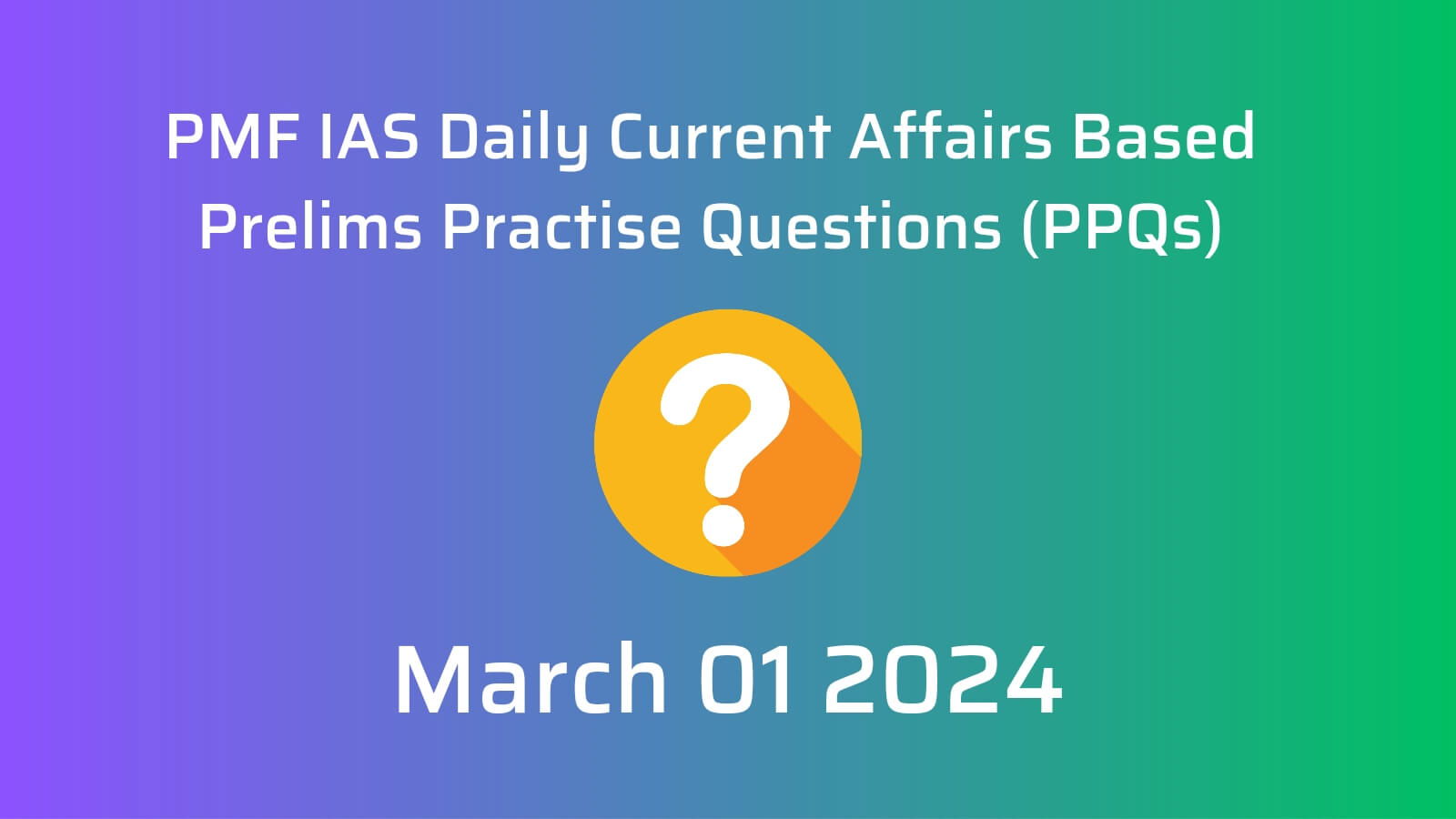
March 01 2024 Prelims Practice Questions (PPQs)
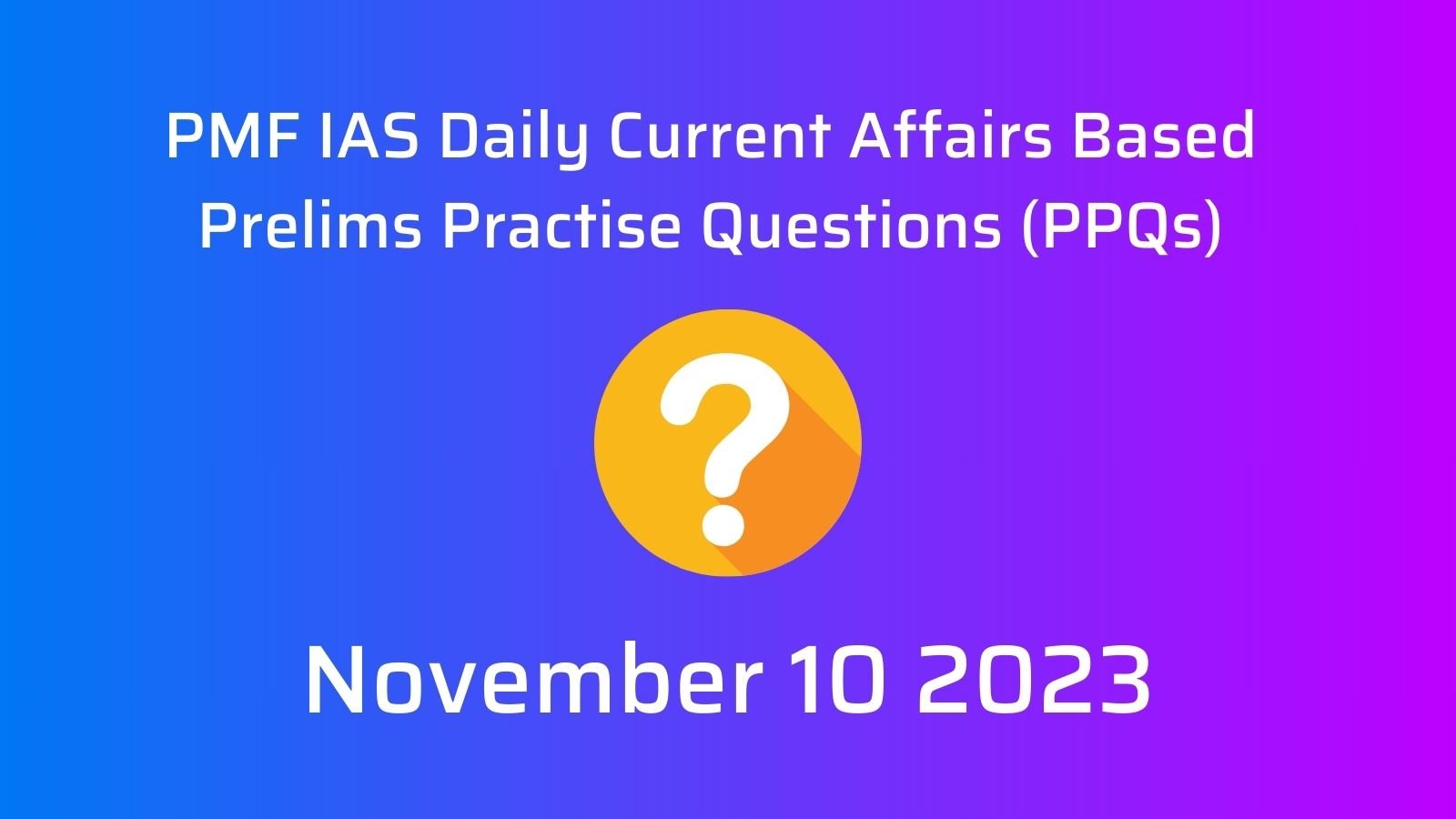
Daily Prelims Practise Questions (PPQs) – November 10 2023
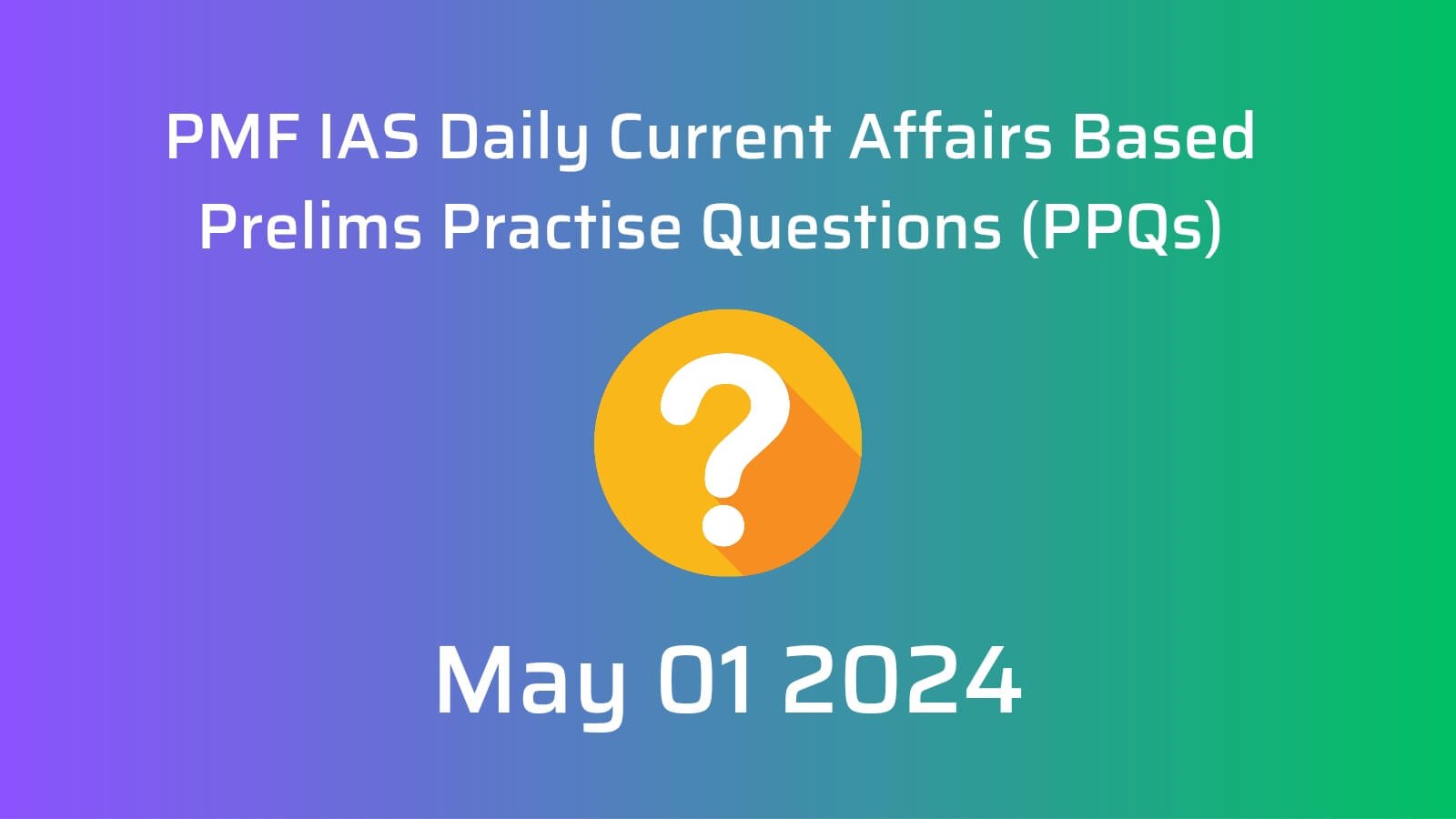
May 01 2024 Prelims Practice Questions (PPQs)

January 04 2024 Prelims Practice Questions (PPQs)
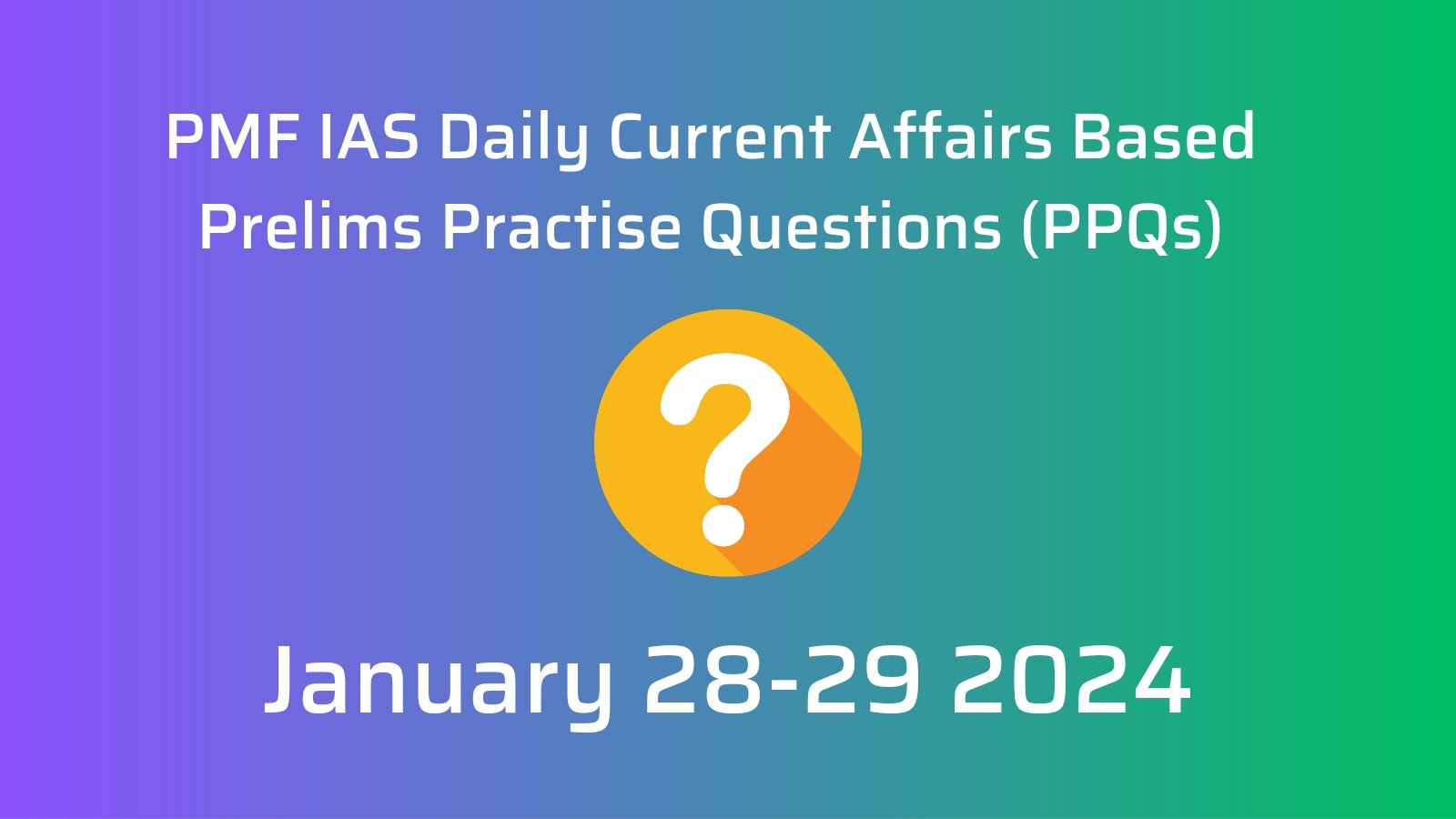
January 28-29 2024 Prelims Practice Questions (PPQs)

December 21 2023 Prelims Practice Questions (PPQs)
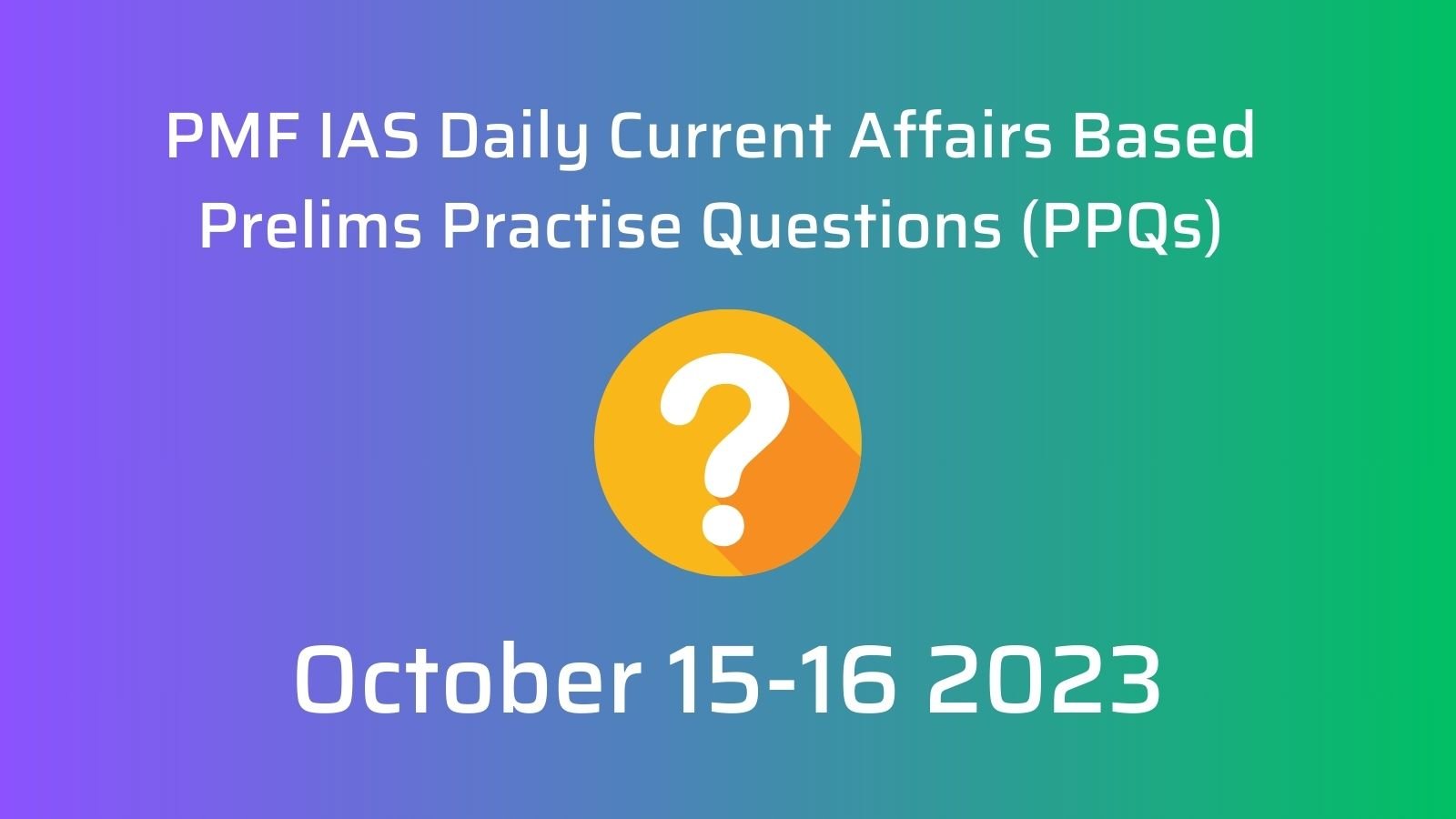
Daily Prelims Practise Questions (PPQs) – October 15-16 2023
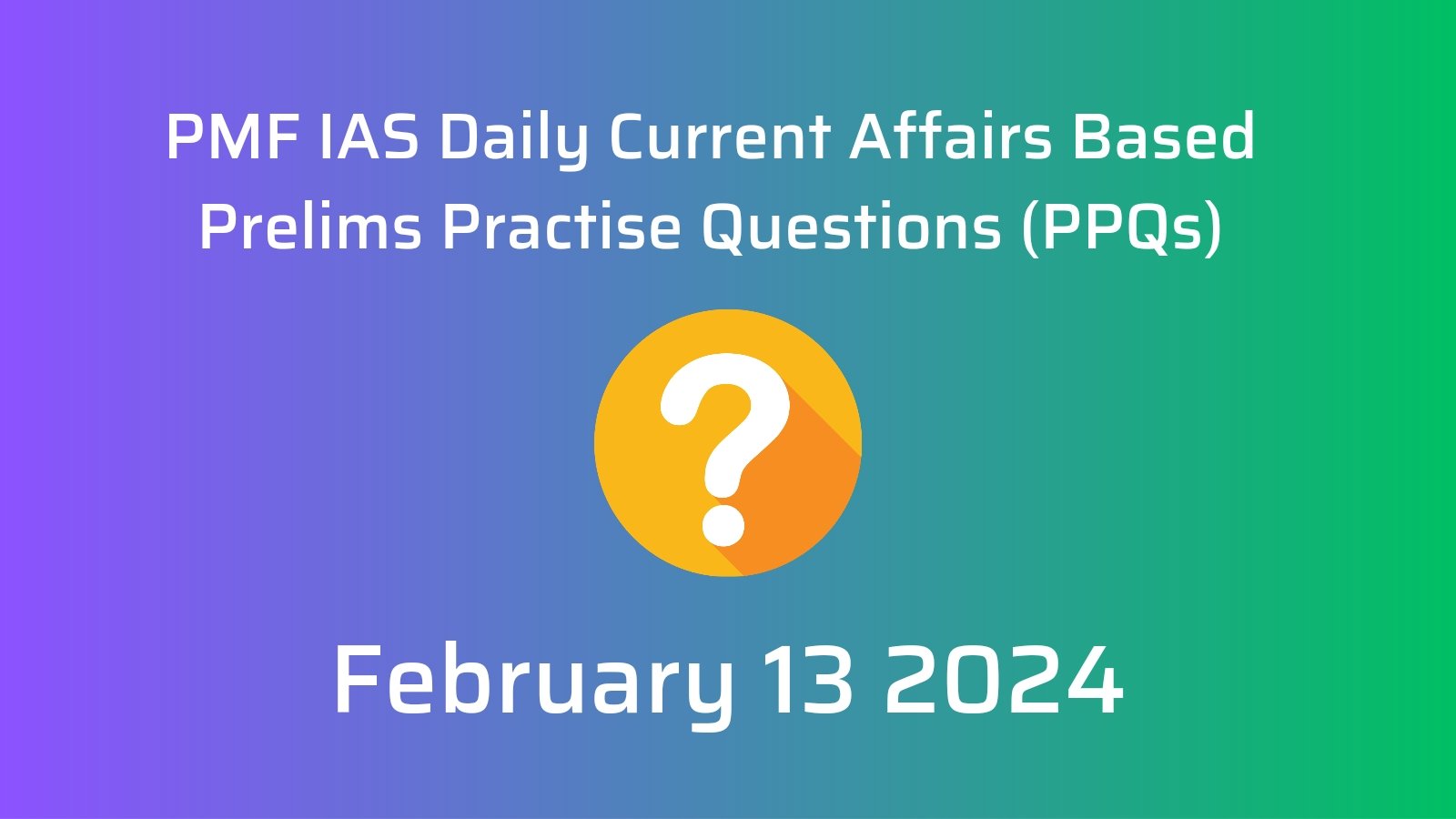





![PMF IAS Environment for UPSC 2022-23 [paperback] PMF IAS [Nov 30, 2021]…](https://pmfias.b-cdn.net/wp-content/uploads/2024/04/pmfiasenvironmentforupsc2022-23paperbackpmfiasnov302021.jpg)





